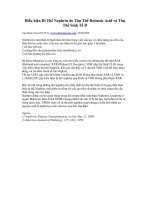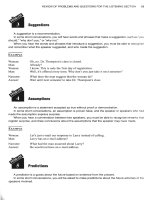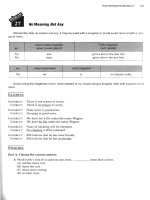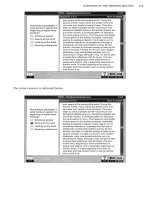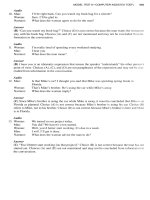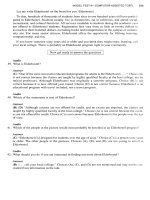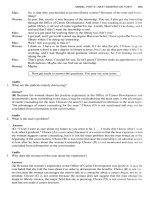The laser: The Solution to ManyProblems doc
Bạn đang xem bản rút gọn của tài liệu. Xem và tải ngay bản đầy đủ của tài liệu tại đây (11.78 KB, 7 trang )
The laser: The Solution to Many
Problems
Like most people, for many years I remained frightened of
the laser, perceiving it as a deadly device capable of
enormous destruction. I recall a scene in a James Bond
movie, Goldfinger, in which Bond, who was tied to a table,
was nearly sliced in half by a laser beam. Since then,
other films and television shows have fuelled my fear of
the laser by showing mad scientists who wanted to take
over the world threatening to use huge laser devices to
wipe out towns and strategic defence areas. Although the
laser does have tremendous potential for destruction, my
unreasonable fear of the laser is fading. In recent years,
scientists have found that the laser has a wide variety of
applications, making it one of the most important
inventions in the last quarter of a century for improving our
quality of life.
One important field in which the laser has many
applications is communications. Scientists have found that
the laser beam can transmit human voices; as a result,
telephone companies are now using laser light signals to
transmit telephone calls through extremely small cables
that are capable of carrying many more transmissions
than the standard telephone cables. An additional
advantage is that these systems using the laser light
signals will also be able to transmit video telephone
conversations in the future.
Another, perhaps less known field in which lasers are
helping improve the quality of life is metrology, which is
the science of measurement. The extremely straight,
narrow laser can be used to align parts of a structure
being built; it can also position the parts on an assembly
line precisely. The laser beam has also been used to
measure remote distances, for example, the precise
distance from the Earth to the Moon. And finally, the laser
can be used to measure the drifts of the Earth’s plates.
This measurement, along with other data, can help in the
prediction of earthquakes.
Probably the most vital application of the laser is in the
field of medicine. Lasers have been devised that cut razor
sharp; in fact, scientists have developed a laser knife that
doctors can use for surgery. These knives are now used
for some general surgery because they cut sharply and
because the beam seals off blood vessels that it severs,
thus reducing blood loss considerably. The laser has also
been used in eye surgery to spot-weld detached retinas to
the back of the eye. A less significant but more curious
use of the laser in medicine is to remove tattoos. Whereas
before tattoos were virtually impossible to remove without
considerable difficulty and pain, now they can be removed
relatively painlessly.
When Dr. Theodore H. Mainan got the first laser to work in
July of 1960, what uses it would have were unknown; in
fact, he called it a multimillion dollar “solution in search of
a problem.” As we have seen,, the use of the laser is
numerous. It is being used in the fields of medicine,
communications and metrology, as we have seen. But I
have just touched down upon some of the applications of
the laser; there are many, many more, not to mention in
the areas of defence and space travel. What should be
apparent by now is that there are many problems the laser
is helping to solve and that the laser, if wisely used, can
be a life-saving device.
